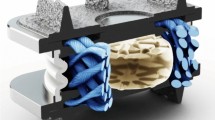Abstract

Introduction
Odontoid fractures are the most common upper cervical spine fracture. There are two mechanisms in which odontoid fractures occur, most commonly hyperflexion of the neck resulting in displacement of the dens anteriorly and hyperextension resulting in posterior dens displacement. Type 2 fractures are the most common and are associated with significant non-union rates after treatment. One possible consequence of an odontoid fracture is a synovial cyst, resulting in spinal cord compression, presenting as myelopathy or radiculopathy. Synovial cysts as a result of spinal fracture, usually of the facet joint, are most common in the lumbar region, followed by the thoracic and then cervical region; cervical cysts are rare. Fracture and subsequent cyst formation is thought to be related to hyper-motion or trauma of the spine. This is reinforced by the appearance of spinal synovial cysts most commonly at the level of L4/5; this being the region with the biggest weight-bearing function. The most common site of cervical cyst formation is at the level of C7/T1; this is a transitional joint subjected to unique stress and mechanical forces not present at higher levels. Treatment of a cervical synovial cyst at the level of the odontoid is challenging with little information available in the literature. The majority of cases appear to implement posterior surgical resection of the cyst, with fusion of adjacent cervical vertebrae to stabilise the fracture, resulting in restricted range of movement.
Case presentation
We describe a case concerning a 39-year-old female who presented with uncertain cause of odontoid fracture, resulting in a cystic lesion compressing the upper cervical spinal cord.
Outcome
Minimal invasive surgery of C1/C2 transarticular fusion was successfully performed resulting in significant improvement of neurological symptoms in this patient. At 1-year follow-up, the cyst had resolved without surgical removal and this was confirmed by radiological measures.






Similar content being viewed by others
References
Anderson LD, D’Alonzo RT (1974) Fractures of the odontoid process of the axis. J Bone Joint Surg Am 56:1663–1674
Maak TG, Grauer JN (2006) The contemporary treatment of odontoid injuries. Spine 31:S53–S60
Ryan MD, Taylor TK (1993) Odontoid fractures in the elderly. J Spinal Disord 6:397–401
Van Gompel J, Morris J, Kasperbauer J, Grander D, Krauss W (2011) Cystic deterioration of the C1–2 articulation: clinical implications and treatment outcomes. J Neurosurg Spine 14:437–443
Denaro V, Papalia R, Di Martino A, Denaro L, Maffuli N (2010) The best surgical treatment for type II fractures of the dens is still controversial. Clin Orthop Relat Res 469:742–750
Riesner HJ, Blattert TR, Katscher S, Josten C (2009) Are there therapy algorithms in isolated and combined atlas fractures? Z Orthop Unfall 147:472–480
Ito T, Hayashi M, Ogino T (2000) Retrodental synovial cyst which disappeared after posterior C1–C2 fusion: a case report. J Orthop Surg 8:83–87
Chang H, Park JB, Kim KW (2000) Synovial cyst of the transverse ligament of the atlas in a patient with os odontoideum and atlantoaxial instability. Spine 25:741–744
Jabre A, Shahbabian S, Keller JT (1987) Synovial cyst of the cervical spine. Neurosurgery 20:316–318
Kazda S, Kocis J, Wendsche P, Jarkovskã J (2009) Comparative clinical study assessing C2 dens injuries treatment outcomes. Rozhl Chir 88:554–558
Lyons MK, Birch BD, Krauss WE, Patel NP, Nottmeier EW, Boucher OK (2011) Subaxial cervical synovial cysts: report of 35 histologically confirmed surgically treated cases and review of the literatures. Spine 35(20):E1285–E1289
Marbacher S, Lukes A, Vajtai I, Ozdoba C (2009) Surgical approach for synovial cyst of the atlantoaxial joint: a case report and review of the literature. Spine 34:E528–E533
Ruf M, Welk T, Mãller M, Merk HR, Harms J (2010) Ventral cancellous bone augmentation of the dens and temporary instrumentation C1/C2 as a function-preserving option in the treatment of dens pseudoarthrosis. J Spinal Disord Tech 23:285–292
Blondel B, Metellus P, Fuentes S, Dutertre G, Dufour H (2009) Single anterior procedure for stabilization of a three-part fracture of the axis (odontoid dens and hangman fracture): case report. Spine 34:E255–E257
Conflict of interest
None of the authors has any potential conflict of interest.
Author information
Authors and Affiliations
Corresponding author
Rights and permissions
About this article
Cite this article
Parks, R.M., König, M.A., Boszczyk, B. et al. Transarticular fusion for treatment of cystic lesion arising from an odontoid fracture. Eur Spine J 22, 21–25 (2013). https://doi.org/10.1007/s00586-012-2194-2
Received:
Revised:
Accepted:
Published:
Issue Date:
DOI: https://doi.org/10.1007/s00586-012-2194-2




